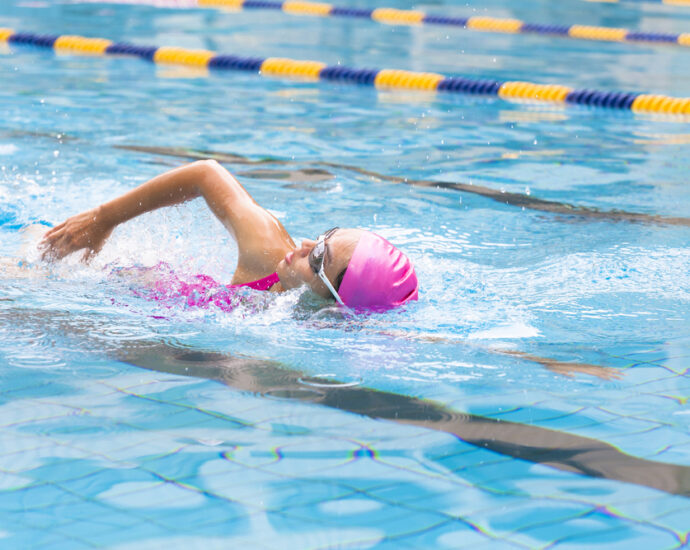Page Contents
Is swimming a good exercise?
Yes, swimming is widely regarded as an excellent form of exercise. It offers numerous benefits for both physical fitness and overall well-being. Here are some reasons why swimming is considered a good exercise:
- Full-body workout: Swimming engages almost all of your major muscle groups, providing a comprehensive workout for your entire body. It works your arms, legs, core, back, and shoulders, helping to improve strength, endurance, and muscle tone.
- Low-impact exercise: Swimming is a low-impact activity, meaning it puts less stress on your joints compared to high-impact exercises like running or weightlifting. This makes it an ideal choice for people with joint issues, injuries, or those seeking a gentler workout option.
- Cardiovascular fitness: Swimming is an excellent aerobic exercise that elevates your heart rate and improves cardiovascular health. It helps increase lung capacity, improve circulation, and strengthen the heart, leading to enhanced endurance and stamina.
- Weight management: Swimming can be an effective exercise for weight loss or weight maintenance. It burns calories at a high rate, with estimates suggesting that an hour of swimming can burn 400-700 calories, depending on factors like intensity and stroke used.
- Low injury risk: Due to the buoyancy of water, swimming carries a lower risk of injury compared to exercises performed on land. The water’s resistance also provides a natural form of resistance training without placing excessive strain on your joints.
- Improved flexibility and coordination: Swimming involves a wide range of movements that enhance flexibility, joint mobility, and overall body coordination. It requires rhythmic coordination between your arms and legs, helping to develop balance and motor skills.
- Mental well-being: Swimming can have a positive impact on mental health. It is often considered a meditative and stress-relieving activity that promotes relaxation, reduces anxiety, and uplifts mood. Being in the water can have a calming effect and provide a break from daily stresses.
What muscles do you use when you swim?
Swimming is a full-body exercise that engages multiple muscle groups. Here are some of the primary muscles used during swimming:
- Latissimus dorsi (lats): These are the large muscles of the back that are responsible for the powerful pulling motion during the freestyle (front crawl) stroke.
- Deltoids: The deltoid muscles located in the shoulders are involved in various swimming strokes, especially during the recovery phase when the arm is lifted out of the water.
- Pectoral muscles (pecs): The muscles of the chest help with the initial catch and propulsion during the pulling phase of strokes like the butterfly and breaststroke.
- Abdominal muscles (core): The core muscles, including the rectus abdominis (six-pack muscles), obliques, and transverse abdominis, provide stability and help maintain proper body position in the water.
- Gluteal muscles: The glutes play a significant role in generating power and propulsion during kicking movements, such as in the flutter kick and dolphin kick.
- Quadriceps and hamstrings: These muscles in the front and back of the thighs are involved in both leg kicking and maintaining body position during swimming.
- Calf muscles: The gastrocnemius and soleus muscles of the calves assist in the kicking movements, particularly during the upstroke of the flutter kick.
- Trapezius and rhomboids: These muscles in the upper back and shoulders help with stabilizing and maintaining proper posture during swimming strokes.
- Biceps and triceps: The arm muscles, including the biceps and triceps, are actively engaged during the pulling and recovery phases of various swimming strokes.
It’s important to note that the specific muscles used and their level of activation can vary depending on the swimming stroke being performed, the intensity of the swim, and individual technique. Swimming is a highly efficient cardiovascular exercise that promotes overall muscle development and endurance.
Warning:
While swimming is generally a beneficial form of exercise for most individuals, there are some cases where certain individuals should exercise caution or avoid swimming altogether. Here are a few examples:
- Non-swimmers: Individuals who cannot swim or have limited swimming abilities should avoid swimming for exercise unless they receive proper swimming lessons and supervision. It is important to develop swimming skills and water safety knowledge before attempting swimming for exercise.
- Individuals with certain medical conditions: People with certain medical conditions should consult with their healthcare provider before swimming for exercise. Conditions such as uncontrolled epilepsy, heart problems, severe asthma, respiratory infections, or open wounds may require restrictions or precautions.
- Individuals with contagious illnesses: If someone has a contagious illness, such as a skin infection (like impetigo) or gastrointestinal illness (such as norovirus), they should refrain from swimming until they have fully recovered. Swimming while contagious can spread the infection to others.
- Individuals with injuries: If someone has a significant injury, such as a broken bone, sprain, or muscle tear, they should avoid swimming until they have fully healed. Swimming with an injury may exacerbate the condition or hinder the recovery process.
- Pregnant women: While swimming can be a low-impact exercise option for pregnant women, it is advisable to consult with a healthcare provider before starting or continuing a swimming routine during pregnancy. Certain complications or individual circumstances may warrant modifications or restrictions.
Takeaway
Remember, as with any exercise, it’s essential to start at a comfortable level and gradually increase intensity or duration as your fitness improves. If you have any specific health concerns or conditions, it’s always a good idea to consult with a healthcare professional before starting a new exercise routine.
